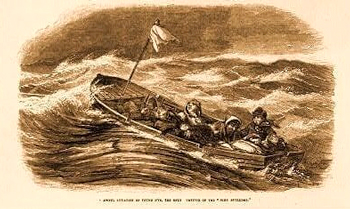The Zone of Danger
by Twain Braden

Artist’s drawing of the lifeboat from the John Rutledge with survivor Thomas W. Nye in Frank Leslie’s Illustrated Newspaper 1856. (Library of Congress)
I recently tried a case before a judge in this district in which I had to prove that my clients had suffered extreme distress on an ill-fated voyage, even though they were not physically impacted in the process. They were not struck by a flying line or lose a limb in a winch. They did not bleed or break any bones. After the voyage, in fact, they walked off the vessel, unharmed by all appearances. What they suffered, however, was compensable because, as the district court found, and as subsequently affirmed on appeal by the First Circuit Court of Appeals in Boston, the experience they had had aboard the vessel was “as frightening as a direct hit.”
Or, in the words of one of the witnesses who testified at trial: “These guys came as close as you can get to dying without actually doing it.”
In recognizing the validity of their injuries, which included psychological symptoms, loss of sleep, extreme anxiety, gastro-intestinal distress, joint pain, and an auto-immune disorder, the court established the “zone of danger” test for maritime law in the First Circuit (which includes Maine, New Hampshire, Massachusetts, Rhode Island, the U.S. Virgin Islands, and Puerto Rico). The court wrote: “Courts applying the test in maritime cases have consistently found that plaintiffs on board vessels that experience near misses are within the zone of danger.” The appeals court found convincing precedent in the 9th Circuit (California) and the 11th Circuit (Florida) and adopted the test here. In each of these other cases a person at sea had witnessed something terrifying, including collisions, fires, capsized vessels, and also been personally at risk of being caught in the carnage themselves (as opposed to being safely ashore or simply observing from a safe distance).
The court therefore
adopted what is described
as “negligent infliction
of emotional distress”
under the general
maritime law.
In describing one such near miss, a Florida court was convinced that certain cruise ship passengers, who had been asleep in their cabins when their vessel collided with another and then come up on deck and witnessed the other vessel in flames, credibly suffered from emotional distress as a result. What they witnessed and been part of was proximate enough for the court to determine that these passengers reasonably believed themselves to be physically in peril, even if they had not actually suffered any physical harm at the time. The passengers “were frightened and were placed in immediate risk of physical harm by the Defendant’s negligent conduct.”
This test requires, of course, that someone’s negligent act was the proximate cause of whatever it is that provoked the incident. For example, someone needed to have misjudged the weather, breached the rules of the road, or allowed a negligent condition to go unchecked.
In our case, the First Circuit acknowledged that the plaintiffs were actually “in more immediate peril” than in the other cases they reviewed. (I like this section of the opinion, since it is basically an acknowledgement that Mainers are tougher than the rest, but even they deserve some recognition of their pain, fear, and subsequent psychological trauma.)
Prior case law had left unresolved as to whether a plaintiff needs to have suffered a “physical consequence” of the traumatic experience. That is, if he had not suffered physical blow, but had later suffered objective, physical symptoms of the distress. The court wrote: “For example, emotional distress may ‘physically’ manifest as a psychological condition — i.e., a nervous disorder or a stress disorder — so long as the condition is capable of objective determination.” This issue had not been previously established as a requirement to recovery. The court left this issue for another day, because it determined that, regardless, my clients had actually met this test, whether or not it was a requirement under the law. They were found to have suffered the effects of post-traumatic stress disorder and a variety of other physical and psychological issues for months afterward as a direct result of their near-death experience aboard the vessel.
The court therefore adopted what is a fairly straightforward test for what is described as “negligent infliction of emotional distress” under the general maritime law in the First Circuit: “In sum, we hold that plaintiffs may recover for [negligent infliction of emotional distress] under the general maritime law.” The test allows recovery where a negligent act has placed someone in a “zone of danger”, which is defined as being “in immediate risk of physical harm by that conduct.”
As stated above, it does not require a physical impact during the harrowing experience, although whether or not it also requires subsequent, physical symptomology remains to be decided by a later case and a later court.
The zone of danger, in addition to having added cache for sounding like a fast-paced action movie, offers clear guidance for folks operating on the water and carrying passengers, either for hire or otherwise. When we operate vessels we do so ever-mindful of a number of dangers that may loom as a result of changing weather, fouled equipment, or other vessels crossing our path. The test reminds us that we have a heightened responsibility for our passengers and crew, not just for their physical safety, but also to be sure they do not “come as close to dying as you can get without actually doing it.”
Twain Braden is a partner at the Portland firm Thompson Bowie & Hatch, LLC, where he specializes in maritime and admiralty law: tbraden@thompsonbowie.com
